Tridax Procumbens / Bisalya karani / বিশল্যকরণী
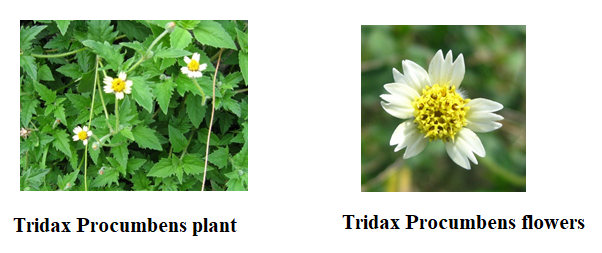
General features: Tridax Procumbens (TP) is a perennial flowering plant of daisy / Asteraceae family belonging to the Tridax genus. The plant, TP is a widespread weed which is native in tropical and subtropical regions around the globe (Africa, Indian subcontinent, Latin American nations). In English it is commonly called Tridax daisy or Coatbuttons. In Bengali and Oriya language it is named as Bisalya karani (বিশল্যকরণী). Despite being registered as a weed in the list of US department of agriculture (USDA), the plant has immense medicinal values especially considering its wound healing, anti-inflammatory, anti-pyretic role and other beneficial role. In many South East Asian Nations, it is listed in the category of medicinal herbs. TP / Bisalya karani earns its eminence for displaying powerful healing act, which has been described in the great Hindu epic, Ramayana. The plant grows wildly throughout India mostly in the meadows, croplands, lawns and roadsides. It expresses white flowers having bright yellow color at the center with daisy like appearance that normally grows ~ 8 inch in height. The leaves are arrow shaped, plump with jagged edge. The plant bears small sized fruit covered with hair with white feathery pappus (like calyx). TP is highly invasive since it produces large number of achenes (like seeds), which can be carried far away by the wind. In several African nations the fresh green leaves are cultivated for use as vegetable and fodders. The leaves are eaten after cooking considering its high nutritional values due to high protein (34.6 %), carbohydrate (51.3 %) and moderate lipid (6.1 %) and fiber (6.1 %) content (% in terms of dry weight). The plant possesses high potassium (32.0 mg / Kg) along with innumerable phytochemicals which are expansively beneficial for health. In Guatemala, it is also used in treating wounds, parasite infections and various other diseases like in gastric and respiratory problems.
Folk use: The leaf juice has antiseptic, insecticidal and anti-parasite properties particularly applicable toward the drug resistance malaria and leishmania also in case of dysentry. It is often used in the villages of tropical and subtropical regions to cure skin infections. As a precious folk medicine, it is used to cure wounds or preventing bleeding. In recent days, studies have indicated its numerous therapeutic actions like, antiviral, antibiotic, wound healing, anti-inflammatory, anti-ulcer, curing anal fistula and hemorrhoids. The plant is exceedingly adored in the Indian state of Orissa and Tamilnadu. It is heavily cultivated for the sake of using as folk medicine. The further use of TP has been noticed to be an effective anticoagulant also for treating any boils and blisters. Below is the table for its use in different countries around the world.
Traditional / Folk uses in different countries
| Country / Region | Extract or Preparations | Diseases used for |
| India | Leaves – Either juice, paste or dry leaves.
Ingested orally or applied topically. |
Controlling hemorrhages, Inflammation, jaundice,
Diabetes, diarrhea, hair loss and helping wound Healing.
|
| Africa | Generally, the entire plant is blended with
Other herbs using water and common salt. |
Treating mastitis within dairy animals. |
| Ghana | Aqueous extract | Anti-malarial, Anti-bacterial, Anti-plasmodial,
And wound healing. |
| Nigeria | Dried whole plant | Fever, Typhoid, Cough, Back ache, Stomach
Ache, Diarrhea and Epilepsy. |
| Benin | Dry whole plant | Livestock feed. |
| Togo | Dry leaves | Dressing wound, pain, malaria, abdominal
Problems and gastrointestinal mycosis.
|
Mythology: The use of TP / Bisalyakarani first came into the lime light from legendary mythological saga of Ramayana, the most celebrated epic belonging to the Hindus of India, written cumulatively between 6th to 11th century AD. In that saga, the use of Bisalyakarani was overtly mentioned that possibly unveiled the popular use. The mythology illustrates that during daring rescue mission by Laxman for his brother’s wife, Sita from the garrison of Sri Lankan emperor, Ravana, he was grossly hurt by the arrow from eminent archer, Meghnad, heroic son of Ravana. Hanuman, the assistant of Laxman sought medical advice from Sushena, the royal Sri Lankan physician. Sushena sent Hanuman to the Himalayan mountain for procuring four herbs, Mritasanjeevani (for restoring life), Bisalyakarani (for healing the wound of arrow), Sandhankarani (for restoring the skin) and Savarnyakarni (for restoring the skin color at the place of wound). But owing to his ignorance, Hanuman could not identify anyone of them within the enormous herbal stalk grown over the mountain top. Instead, he carried the entire hill top with him. While being unable to carry further, he dropped the load before reaching to the Sri Lanka which in recent days is located between Balangir and Bargarh district in the state of Orissa, India. Sushena came forward and being an outstanding physician, he identified the herbs and successfully applied them. Following that course of treatment, Laxman healed and survived which eventually helped afterward bringing down the Sri Lankan empire of Ravana. Thus, Sita has been rescued unharmed. Among those healing herbs, Bisalyakarani was described to be the prominent one. The mythology intimately entangled with the then history, in fact indicates an expedition occurred to the south carried out by a northern ruler in amorphous ancient India. In that event Bisalyakarani / TP was discovered which in turn found numerous beneficial applications later in the field of folk medicine. In village remedy, the juice or paste made of fresh leaves is often applied directly to the wound helping expedite the healing process also protecting the wounded site from inflammation and possible infections.
Chemical components and medicinal effects: In general, the herb contains a large reserve of alkaloids, phytosterols, hydroxycinnamates, lignans, flavonoids carotenoids, various terpenes (higher amount α and β – pinenes) and tannins. The total flavonoids content is ~ 6.5 g / Kg of dry leaf. About 23 flavonoids have been detected. The leaves also had moderate levels of tannins (0.8 g / Kg), hydroxycinnamates (0.6 g / Kg), phytosterols (0.3 g / Kg) and low benzoic acid derivatives (0.03 g / Kg), lignans (0.08 g / Kg) and low carotenoid contents (0.001g / Kg). The total alkaloid content is noticeably high ~ 10.2 g / Kg in the leaves. Below is the table for the major ingredients that are estimated to be in highest level.
Components of maximum content
| Category | Name | Content
(Maximum level) |
| Alkaloid | Akuammidine
Voacangine Echitamine |
70.4 g / Kg
16.9 g / Kg 5.1 g / Kg |
| Flavonoids | Kaempferol
(-) Epicatechin |
11.5 g / Kg
8.2 g / Kg |
| Phytosterols | Stigmasterol | 2.1 g / Kg |
| Tannins | Tannic acid | 8.2 g / Kg |
| Carotenoids | Lutein | 0.009 g / Kg |
| Hydroxycinnamates | Caffeic acid | 5.8 g / Kg |
| Benzoic acid derivatives | Ferulic acid | 0.2 g / Kg |
| Lignans | Galgravin |
0.6 g / Kg |
Alkaloids- Interestingly a large quantity of indole alkaloids is produced both in leaves and stems of the plant. About 39 alkaloids are isolated and identified so far from the aqueous extract. It is believed that there could be more unidentified ones in the pedicle and buds. The unknown alkaloid fraction extracted from those parts shows strong anti-microbial property against Proteus mirabilis (microbe helping kidney stone formation) and Candida albicans (causing Yeast infection in guts and vagina). The extract from bud shows activity against E. coli and Trichophyton mentagrophytes (fungus making ring worm). Experiments indicate that these alkaloids exert quite a different physiologic effects. For example, Akuammidine acts as opiate agonist that binds with µ -, δ – and κ – receptors having the Ki = 0.6, 2.4 and 8.6 µM / L. The in vitro bioassay shows that its actions can be antagonized by using Naloxone or specific µ – receptor antagonist (D-Phe-Cys-Tyr-D-Trp-Orn-Thr-Pen-Thr-NH2). Akuammidine also displays antibacterial, antifungal, anti-malarial, anti-inflammatory, hypotensive, anti-depressant, muscle relaxant and local analgesic properties. On the other hand, Voacangine shows potent anti-angiogenic action. Angiogenesis, the formation of new blood vessels is the key factor in the path of tumor growth. The development of anti-angiogenic compound is one of the ways to control the progression of solid tumors and metastasis. Voacangine isolated from numerous plant sources including TP is a novel anti-angiogenic compound enabling to stop angiogenesis in vivo and in vitro experiments (IC50 ~ 15 µM) without affecting the normal cells. Additionally, besides its anti-angiogenic action, the compound also shows strong anti-oxidant and anti-acetyl-cholinesterase property that may help control the Alzheimer’s progression. The compound exerts several other actions eg, CNS depressant, anti-convulsive, anti-pyretic, analgesic, anti-mycobacterial, cardio-vascular toning and local anesthetic. The other significant indole alkaloid, Echitamine also shows few important biologic effects while acting as anti-cancer, anti-bacterial, antitussive and anti-fertility component. In addition, it also exerts diuresis, CNS depression, hypotensive and anti-epileptic effects.

Flavonoids – They are everywhere, in leaves, buds and stems. They can act as anti-coagulant, anti-fungal, hair tonic, prevents various bronchial problems, diarrhea, dysentery and wound healing. The TP leaves contain high level of flavonoids, ~ 25 in total. All of them have beneficial role on health. As shown in the table, besides expressing large quantity of kaempferol (~ 18 %), epicatechin (~ 8.2 %) and biochanin (~ 8.0 %), the leaves also have other flavonoids eg, (+) catechin, apigenin, naringenin, quercetin, genistein, butein, gallo-catechin, luteolin, myricetin, robinetin and many others in moderate or lesser amount. Additionally, there are few new components recently identified. One of them is Procumbenetin, a glycosyl linked flavone which has shown strong antioxidant and hypolipidemic action on animals. The compound and its analogs also have ability to prevent formation of kidney stone by blocking Ca and oxalate deposition inside the kidney. On the other hand, Procumbenetin does not express antifungal activity. These flavonoids can regenerate damaged β – cells in the pancreas. It has been noticed among the diabetic animals that daily consumption of TP juice especially the flavonoid fraction can induce hypoglycemic effect and lower VLDL and cholesterol. In general, most flavonoids provide strong anti-oxidant effect by scavenging the reactive oxygen or nitrogen species protecting from cardiovascular disorders, kidney diseases, hypertension and cancers. Luteolin shows anti-inflammatory and anticarcinogenic actions which could be due to its antioxidant actions. Like luteolin many of the flavonoids display anti-tumor effect. Some of them exert anti-angiogenesis, block metastasis, helps DNA repair and inhibits cancer cell replication also promoting apoptosis. In a way, flavonoids exert remarkable positive actions toward the health.
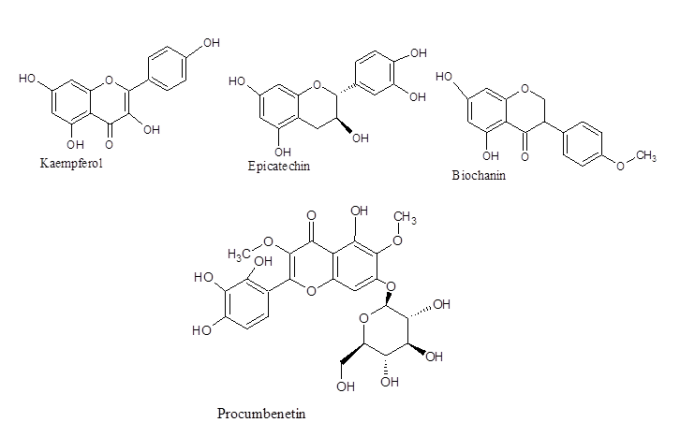
Tannin – The tannin (8.2 g / Kg dry weight) available inside TP is tannic acid (pKa ~ 10) which exists in moderately high level providing strong antioxidant effect. It is water soluble polyphenol found mainly within the plant kingdom. Tannin fraction of TP offers anti-microbial, anti-carcinogenic and anti-mutagenic properties. All these effects might arise due to the strong anti-oxidant nature.
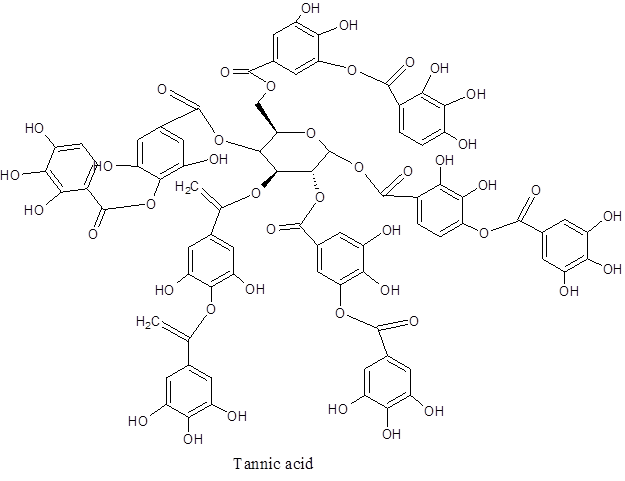
Carotenoids – The carotenoid fraction in TP is mostly Lutein (9.0 mg / Kg dry weight) which is a xanthophyll, naturally occurring carotenoids synthesized only within plants. It is a yellow pigment helping the process of light harvesting during photosynthesis. The pigmentation occurs attract the insects. Lutein protects tissues from any photooxidative damage. The consumption of Lutein prevents oxidative DNA damage because of its potent anti-oxidant action. It helps maintain epithelial tissues through the conversion to vitamin A which is a necessary factor for maintaining immunity, hematopoiesis also inhibiting the possibility of night blindness.

Lignan – The noticeable one is Galgravin. It is produced from Ferulic acid. This polyphenolic compound has versatile beneficial effects. For example, it is an anti-trypanosomal compound which is really a very prominent property since that affects many in tropical countries. Further, the compound inhibits Platelet Activating Factor (PAF) receptor binding also shows strong antiviral action toward HIV-1 and foot mouth disease.
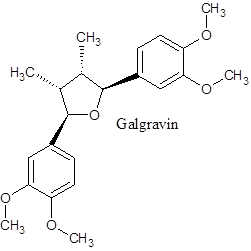
Hydroxycinnamate and benzoic acid derivatives – The plant expresses high extent of Caffeic acid (8.2 g / Kg dry weight) but very low level of Ferulic acid (0.2 g / Kg dry weight). Both have positive effects on health. Caffeic acid inhibits cancer cell proliferation. Like Ferulic, Caffeic acid is a strong anti-oxidant also acts as anti-inflammatory components. Caffeic acid is a natural fungicide enabling to inhibit the production of Aflatoxin. It also significantly reduces the progression of colon tumors. Caffeic acid is a precursor of Ferulic acid. The later is also strong antioxidant behaving by scavenging the ROS thus prevents DNA damages.

Analysis of various parts of TP plant reveals that the chemical content of all categories is high mainly in the leaves. The plant possesses innumerable compounds which has the wonderful medicinal role. Many of them are not mentioned or discussed above, eg, the alkaloid Lupanine or a diterpene Augustafolin. Lupanine acts as a cholinergic drug causing CNS depression and has the antiepileptic, oxytocic and anti-arrhythmic, hypoglycemic plus hypotensive role. On the other hand, Augustafolin is a strong bacteriostatic agent.
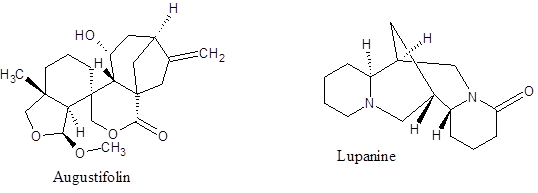
Pharmacological actions: The pharmacological role of TP is numerous. The compounds synthesized within TP have versatile medicinal role. They can prevent anemia, boost immune system, act as antioxidant, anticancer, antifungal, antibacterial, antiparasitic, antiviral and anti-plasmodial.
Anti-inflammatory – The anti-inflammatory action is conceivably due to its potent antioxidant effect. Reports indicate that poultice prepared by using TP leaves can reduce experimentally induced inflammation to a significant extent. The extract can also be used both orally and topically for the reduction of inflammation which is seen somewhat superior to Ibuprofen or Aspirin. Advantageously, it does not cause ulceration or create any adverse reaction which is a major concern for them.
Hepatoprotective effect – The reports on animal data using experimentally induced various liver problems confirms the impressive power of hepatoprotection by TP extract. The underlying factor(s) are appeared to be flavonoids. Additionally, animals treated with TP show no adverse effects at all.
Anti-cancer effect – Numerous studies indicate a great promise regarding its use to reduce or prevent number of different cancers. Considerable inhibitory effects are noticed for prostate and lung cancers. The TP extract efficiently blocks angiogenesis. In addition, it also shows enhanced expression of P53 and Caspase which help induce apoptosis for the tumor cells.
Antihypertensive effect – In many areas of the world, TP is traditionally used to lower the hypertension. Studies on experimentally induced animal shows the effect being comparable to captopril. The plausible mechanism could be either due to the vasorelaxation or diuretic role of various flavonoids.
Antidiabetic action – The studies on experimental animals reveal that TP consumption acts better than Glibenclamide, a common drug used to control type – 2 diabetes that works by stimulating the release of insulin from pancreatic β – cells. But unlike the drug the herb acts by lowering the enzymatic action of α – amylase and α – glucosidase which are liable for the breaking down of carbohydrates.
- A) Anti-microbial, B) antifungal, C) antibacterial and D) antiparasitic effect – A) Anti-microbial effect has been noticed against subtilis, B. faecalis, E. Coli and Pseudomonas aeruginosa which is presumably due to the existence of alkaloids. B) The antifungal stains that are affected are Microsporum fulcum, Microsporum gypseum, Trichophyton mentagraophytes, Tricophyton rubrum, Candida albicans and Tricophyton beigelli. But no specific fractions or compounds have been identified yet. C) The extract from TP is seen to be effective against Mycobacterium smegmatis, E. Coli, Kleibsiella sp, Salmonella group C, Salmonella paratyphi and several other types also. D) The anti-parasitic actions are against malaria, leishmania and other protozoa infections like dysentry, vaginitis, malaria and colic.
Below is the table for summarized version of various pharmacological effects of TP.
Pharmacological effects of TP
| Pharmacological role | Effects | Phyto-components |
| Antioxidant action | Anti-inflammatory, Antioxidant
& Anticancer. |
Poly – phenols, Flavonoids, carotenoids and
Alkaloids. |
| Anti-cancer action | Cytotoxicity against many
Malignant tumor cells. |
5, α – cholestane, monoterpenes (α and β –
Pinenes). |
| Anti-hypertensive effect | The effect is comparable to the drug
Captopril. |
Suspected components are flavonoids and
Alkaloids. |
| Hepatoprotective action | Lowering of oxidative stress.
Lowering of serum aspartate Aminotransferase, serum alanine Aminotransferase, serum alkaline Phosphatase and serum bilirubin. |
Suspected agents are alkaloids and
Flavonoids. |
| Antidiabetic effect | The effect is comparable to the drug
Glibenclamide. |
Saponins. |
| Immuno-boosting effect | Increment of neutrophil percent in
the experimental animals. |
Possible components are tri- and
sesquiterpenes. |
| Anti-microbial, Antifungal,
Antibacterial & Anti-parasite |
Already mentioned. | α – & β – pinenes, Alkaloids, Flavonoids,
monoterpenes & Oxylipin. |
The beneficial role of TP is legendary due to the existence of multitude of phytochemicals. The plant has been in use as a folk medicine for different needs in various regions of the world. Interestingly, the plant is also used as vegetable in several regions. So, including it as a vegetable in the daily diet may cure or prevent many of the illnesses.
